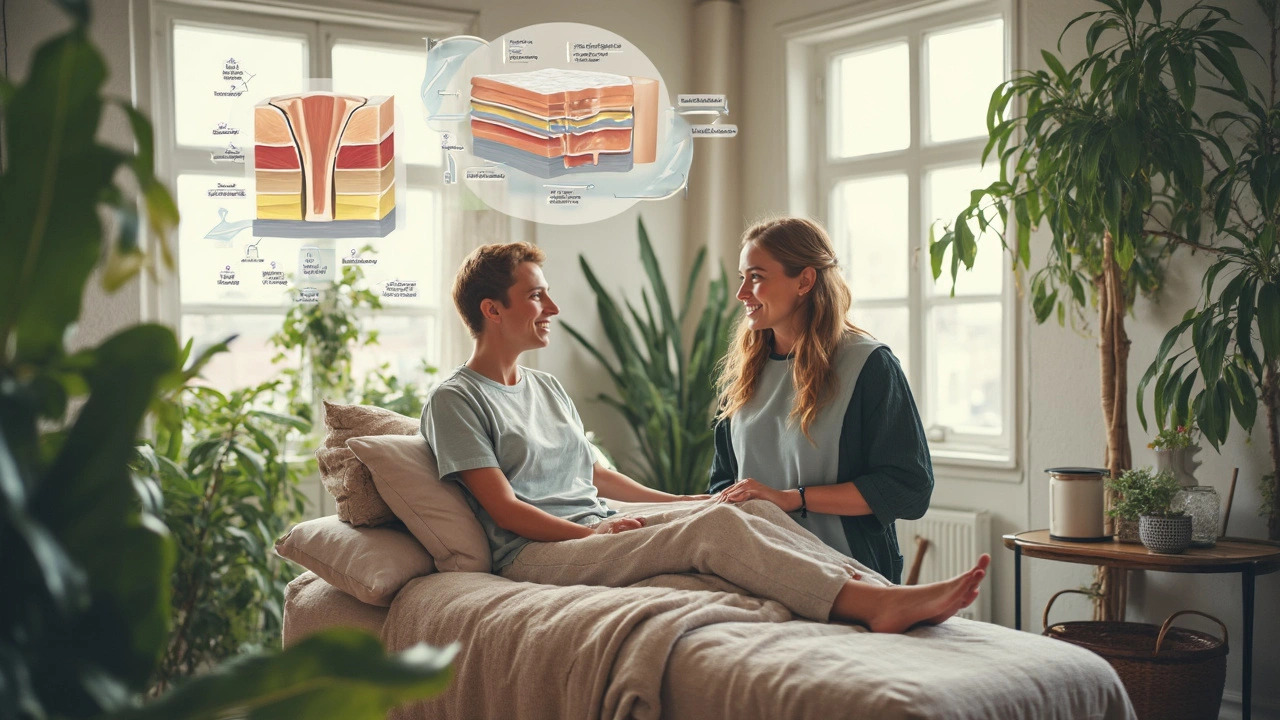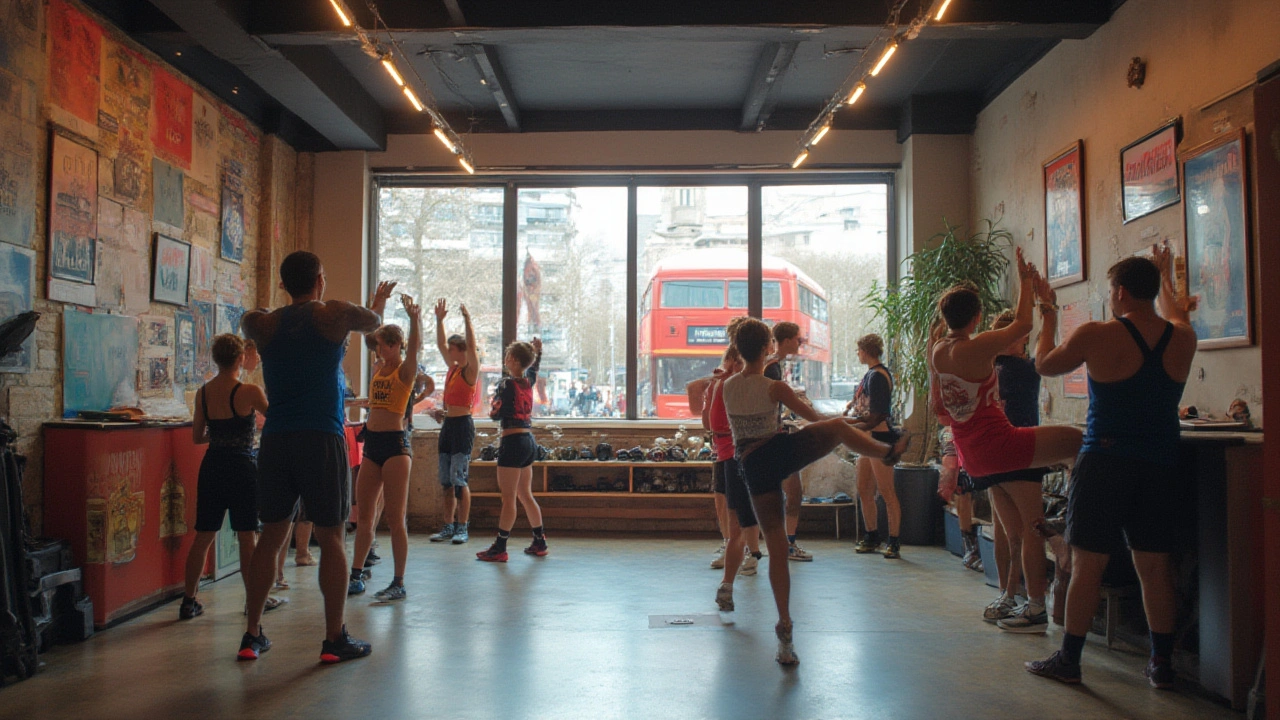Feeling stiff or burned out? Regular massage sessions near you are more than just a treat—they can boost your mood, cut stress, and even help with pain relief. This guide breaks down the real-life benefits of booking a local massage, what to expect, and how to choose the right service. You'll also find tips for keeping your sessions safe and affordable. Ready to upgrade your self-care routine?

- Created by: Archer Caldwell
- Completed on: 20 Jun 2025
- Categories: Deep Tissue Massage
Ever catch yourself hunched over your phone or slouching at your desk and wonder why your back hurts? You're definitely not alone—bad posture sneaks up on all of us, even my teenager Finley. If you've Googled how to fix it, you’ve probably seen deep tissue massage pop up more than once. But does it really help, or is it just another wellness buzzword?
The quick answer: deep tissue massage actually targets the tight spots and muscle knots that are messing with your alignment. It’s not just about feeling good in the moment. Therapists use firm, focused pressure to work out those sneaky, deep-rooted muscle adhesions—the stuff that keeps your shoulders rounding forward or makes your lower back stiff. Over time, your muscles start relaxing into their natural position, making it a whole lot easier to sit or stand straight without effort.
If you’re sick of stretching every hour or buying another ergonomic chair, deep tissue massage gives your body the nudge it needs. Curious what a session feels like, or how to find the right therapist? You’ll want to know what to expect before your first visit, so stick around—you’re about to get answers that could make a difference for your posture (and your daily comfort).
- Key Takeaways: Quick Facts on Deep Tissue Massage for Posture
- How Deep Tissue Massage Changes Your Posture
- What Happens in a Deep Tissue Massage Session
- Choosing the Right Therapist for Posture Issues
- Safety and Aftercare for Best Results
- Deep Tissue Massage vs. Other Posture Tools: What Works Best?
Key Takeaways: Quick Facts on Deep Tissue Massage for Posture
If you’re wondering if deep tissue massage can actually help with your slouching or stiff back, here are the no-nonsense facts you need to know:
- Deep tissue massage isn’t just a fancy rub-down—it actually gets in there to break up adhesions and scar tissue that mess with how your muscles hold your bones.
- Regular sessions help loosen tight, overworked muscles, especially in your shoulders, neck, and lower back—exactly where bad posture likes to show up.
- By releasing tension in those stubborn spots, your body naturally starts to line up better. This makes it easier to keep good posture without always thinking about it.
- People who work at a desk or spend long hours driving often see big improvements, sometimes feeling taller or lighter after just a few sessions.
- Unlike quick-fix stretches or posture braces, deep tissue massage works at the root cause—those chronic knots and muscle imbalances—so the results actually last.
- You don’t need to be an athlete to see results. Anyone who battles with desk hunch or tech-neck can benefit.
- Some soreness after the first session is normal, but it fades fast and is usually a sign that tight muscles are finally letting go.
If you’re sick of nagging aches and are tired of telling yourself to "sit up straight," adding deep tissue massage to your routine might be a real game changer.
How Deep Tissue Massage Changes Your Posture
Most people think posture is just about standing up straight. In reality, posture problems usually start with tight, knotted muscles—especially in your neck, shoulders, and lower back. These knots, called adhesions, pull you out of alignment. This is where deep tissue massage really shines.
During a deep tissue massage, the therapist applies slow, focused pressure to the deeper layers of muscle and connective tissue. This isn’t your standard relaxing spa rubdown—it’s about breaking up those stubborn adhesions that stop your body from moving the way it should. By loosening these trouble spots, your body can reset itself, helping you naturally stand or sit straighter.
Here’s how it works step by step:
- Releases Tightness: Deep pressure targets knots and scar tissue, letting muscles relax and lengthen. Less tension means your spine can return to its natural, upright position.
- Boosts Blood Flow: More circulation means your muscles get extra oxygen and nutrients, speeding up recovery and making it easier to stay active with good posture.
- Improves Flexibility: Regular sessions make joints less stiff and give you more range of motion—key for simple things like reaching or turning your head without pain.
- Reduces Pain: Clearing up chronic tension in areas like the shoulders and lower back helps your body feel better, so you’re not forced into weird compensating positions just to avoid discomfort.
You might be surprised to know just how many people benefit. Here’s a snapshot from a recent industry survey about deep tissue massage and posture support:
| Benefit Reported | % of Clients Noticed Improvement |
|---|---|
| Improved shoulder/neck alignment | 82% |
| Less lower back tension | 77% |
| Became more aware of posture daily | 69% |
That’s not hype—those numbers reflect real-world results. You’re not just loosening muscles during a session; you’re helping your body relearn how to hold itself. It feels different after a few treatments. You’ll catch yourself sitting taller without even trying, and simple stuff—like carrying groceries—won’t throw your back out anymore.
If you’re battling desk-job slouch or years of bad habits, adding deep tissue sessions to your routine might finally tip the scales in your favor. Just keep in mind: real change isn’t instant. Most folks see the best results when they combine massage with movement, like stretching or light exercise. It’s about building new muscle memory so your body stays in good alignment long after you leave the massage table.
What Happens in a Deep Tissue Massage Session
First things first, don’t expect spa music and feather-light touches. A deep tissue massage is all about real results for your body—and the therapist means business. When you walk in, they’ll usually start with a quick chat. They’ll ask where you’re feeling tight, if you’ve got posture issues, or if certain movements bug you. This isn’t small talk; it sets the stage for targeting the exact spots causing those everyday aches.
You’ll be asked to undress to your comfort level and lie under a towel or sheet. Most sessions run about 60 minutes, but if you want them to focus on more problem areas, some go for 90. Once you’re settled, the therapist uses firm, slow strokes and deep finger pressure. They might work with elbows, knuckles, or even their forearms. Sometimes you’ll feel a gritty, almost tender sensation in problem spots—those are adhesions or knots. Getting through these helps free up stiff muscles so you can move better and improve alignment.
One big difference from Swedish or relaxation massage: in deep tissue, the pressure goes beneath surface muscles. The therapist is looking to break up scar tissue and lengthen shortened, tense muscle fibers. They’ll often check in with you: “Too much pressure?” If it gets too intense, always speak up! Pain shouldn’t be sharp or overwhelming. You should feel like that spot is "hurting so good," but not wincing on the table.
Here’s what a typical deep tissue massage session looks like for deep tissue massage:
- Initial chat about your pain points and posture issues
- Slow, focused strokes and pressure on tight areas
- Deep work on knots, sometimes using elbows and knuckles
- Plenty of checks to make sure the pressure is right for you
- Tips at the end about stretches or habits to maintain the results
Don’t be surprised if you’re a little sore when you get up—think of it like the way your muscles feel after a workout, but in a good way. Most folks notice they can stand straighter and breathe deeper right after the session, and the real improvements build with repeat visits.

Choosing the Right Therapist for Posture Issues
Picking the right person for your deep tissue massage isn’t just about who has the fanciest website or brightest smile. When posture is your goal, you need someone who understands not just massage, but how posture really works in the body.
Start by making sure your therapist is licensed and trained in deep tissue massage. Don't be shy about asking where they studied or how much experience they have with clients struggling with posture problems. Experience matters: the American Massage Therapy Association says therapists with more years under their belt are far more likely to recognize the subtle muscle imbalances that mess with alignment.
"A skilled massage therapist will not only ease muscle tension but will also educate clients on their posture, self-care, and long-term solutions," says Dr. Emily Splichal, a podiatrist and human movement specialist.
Some therapists actually specialize in posture correction or work closely with chiropractors, physical therapists, or trainers. If you see a lot of office workers or athletes praising someone in local reviews for posture help, that's a great sign. Check for credentials like certifications in myofascial release, sports massage, or even neuromuscular therapy. These extras show your therapist is serious about results, not just relaxation.
When you book, ask these:
- Have you worked with clients aiming to fix posture and alignment?
- Do you use assessments to spot asymmetries or problem areas before starting?
- Do you offer tips for at-home stretches or lifestyle tweaks?
- Are you comfortable working with previous injuries or back pain?
You can also get a sense of their approach in the first session. A good therapist will take time to check your posture, maybe even have you stand or move so they see where the issues are. If a therapist just jumps in without a chat or assessment, that’s a red flag.
Dig into reviews online or ask for word-of-mouth recommendations. A recent 2024 survey from MassageBook found that 61% of clients who sought massages for posture picked their therapist based on a friend’s recommendation or online reviews.
| Qualification | Why It Matters |
|---|---|
| Massage Therapy License | Guarantees they've met minimum standards for safe practice |
| Experience with Posture Issues | The more times they've helped, the better they spot root problems |
| Extra Certifications (e.g., Myofascial Release) | Shows advanced skill in targeting stubborn muscle knots |
| Collaborates with Health Pros | Better coordinated care if you need more than massage |
You’ll want someone who’s willing to listen, adapts their techniques to your needs, and checks in on your progress. A great deep tissue therapist isn’t just pushing elbows into your back—they’re a teammate, there to help you move better every day.
Safety and Aftercare for Best Results
Deep tissue massage can do wonders for posture, but you want to play it smart, especially if you’re new to it or have health concerns. Most healthy adults can safely get this type of massage, but it’s not for everyone. If you have blood clotting disorders, take blood thinners, or have skin infections, check with your doctor first. Pregnant women should also talk to a healthcare provider, since not all massage techniques are safe during pregnancy.
“Always communicate with your massage therapist about pressure levels and any discomfort you feel—pain isn’t a sign of effectiveness,” says Dr. Tiffany Field from the Touch Research Institute.
During your first session, start slow. Let your therapist know if something doesn’t feel right—sharp pain or numbness are red flags. Bruising can happen (it’s pretty common after deep tissue work), but heavy bruises or lingering pain shouldn’t be ignored. If this happens, cool the area with an ice pack and avoid heavy workouts for 24 hours.
- Hydrate like crazy after your session. Drinking water helps flush out the stuff your muscles just released—it’s simple, but it really makes a difference.
- Give your body some rest. No intense workouts or heavy lifting for a day or two, especially if you’re feeling sore. This lets your muscles repair and adjust to their new, relaxed state.
- Warm baths or showers can soothe sore spots. Just keep it mild—skip extreme hot or cold.
- If you notice swelling, try a cold compress for 15-20 minutes. It’s old school, but it works.
Keep in mind, everyone reacts differently. Some feel energized, others sleepy. Listen to your body and go easy after your massage. If you have any weird symptoms—numbness, intense headache, or skin reactions—call your therapist or healthcare provider right away.
Taking care of yourself after a massage isn’t complicated, but it’s key to getting the most out of each session. When you follow these tips, your body can rebound better and you’ll see those posture improvements stick around longer.
Deep Tissue Massage vs. Other Posture Tools: What Works Best?
Let’s be real—hundreds of posture tools crowd the market, and every one claims to be the ultimate fix. From posture corrector braces to ergonomic chairs, foam rollers to yoga stretches, it’s a jungle of options. But how does deep tissue massage actually stack up against everything else?
The cool thing about deep tissue massage is how it zeroes in on the root of most posture problems—tight, ‘stuck’ muscles. When muscles bunch up and shorten from sitting all day, no amount of gadgets can truly “pull” them back into line. A massage therapist, on the other hand, can physically break up those knots and lengthen muscle fibers so your body can find good alignment naturally. That’s something posture braces and fancy chairs just can’t do.
Here’s how deep tissue massage compares with a few other common posture tools:
| Tool/Method | Main Benefit | Limits | Best For |
|---|---|---|---|
| Deep Tissue Massage | Releases deep muscle tension, improves flexibility, supports realignment | Requires professional, not instant relief, may feel sore after | Persistent knots, chronic poor posture, tension headaches |
| Posture Braces | Helps retrain your awareness, offers support | Can weaken muscles if overused, uncomfortable for long | Short-term reminders, desk work breaks |
| Stretching/Yoga | Improves flexibility, strengthens postural muscles | Needs consistency, won’t break up deep knots alone | Daily habits, prevention, milder stiffness |
| Foam Rolling | Self-massage to reduce muscle tightness, affordable | Surface level, technique-sensitive, awkward in some areas | Quick muscle relief, warming up or cooling down |
| Ergonomic Gear | Supports posture, reduces strain while sitting | Doesn’t fix muscle imbalances, can be expensive | Long office hours, at-home work setups |
If you only ever use posture correctors or ergonomic gadgets, you might feel less sore, but those underlying muscle issues probably won’t budge. On the flip side, only doing deep tissue massage without any daily habits (like stretching or using a proper chair) likely won’t stick either. Most people need a mix—think of massage as your reset button, while daily tools and mindful movement help keep the good results going.
Here’s a practical combo that tends to work for lots of folks (me included!):
- Get a deep tissue massage (or two) to address stubborn tightness.
- Use a simple posture cue—like a yoga strap or phone reminder—when working or studying.
- Stretch key muscle groups every day (upper back, hip flexors, chest).
- Make your desk comfortable: higher screen, feet flat, back supported.
What’s the best tool for posture? The one that gets your muscles moving the right way, every day. If you can, try pairing massage with a few actionable changes—your body (and mood) will thank you.
Discover London’s most effective sports massage techniques, how they help with injury recovery, and where to find the best therapists in the city.
Discover how a personalized full body massage can relieve stress, ease chronic tension, and restore balance to your body. Learn the types, benefits, what to expect, and how to find the right therapist for you.



